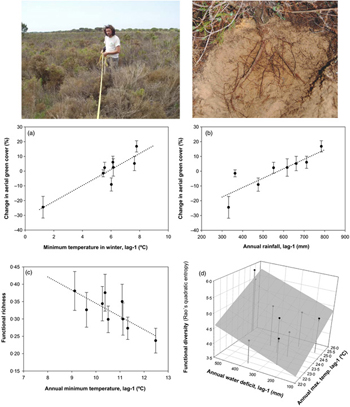Understanding how different factors mediate the resistance of communities to climatic variability is a question of considerable ecological interest that remains mostly unresolved. This is particularly remarkable to improve predictions about the impact of climate change on vegetation. Here, a trait-based approach is used to analyse the sensitivity to climatic variability over 9 years of 19 Mediterranean shrubland communities located in southwest Spain. The role of functional diversity (FD) and soil environment as drivers of community stability is evaluated. The studied shrubland communities were strongly sensitive to inter-annual variability in climate. First, colder and drier conditions caused remarkable decreases in total plant cover but increased FD, likely because the reduction of plant cover after harsh climatic conditions promoted the expansion of functionally dissimilar species in the new open microsites; although communities returned to their initial values of plant cover after nine years, changes in FD and structure persisted over time. Second, drier and colder conditions favoured the predominance of shrubs with a conservative resource-use strategy, bigger seeds and a more efficient use of water. The most functionally diverse communities were the most stable over time in terms of species diversity, likely because a higher number of functionally dissimilar species allowed compensatory dynamics among them. Communities inhabiting more acidic and resource-limited environments were less variable over time, probably because they were mainly constituted by slow-growth, stress-tolerant species that are potentially better adapted to harsh climatic conditions. This study, using data from the Long-Term Monitoring Program of Doñana Natural Space, highlights the utility of a trait-based approach to evaluate how plant communities respond to climatic variability. The increased frequency of extreme climatic events predicted by climatic models will alter the functional structure of shrubland communities, with potential repercussions for ecosystem functioning. These results also provide new insights into the role of FD and soil environment as buffers of the climate impact on woody communities, as well as potentially useful information to be applied in ecologically based management and restoration strategies. Pérez-Ramos et al (2017) Climate variability and community stability in Mediterranean shrublands: the role of functional diversity and soil environment. J Ecol doi:10.1111/1365-2745.12747
http://onlinelibrary.wiley.com/doi/10.1111/1365-2745.12747/abstract;jsessionid=9973907E998034820261E1915740091E.f04t02








 Las altas temperaturas están provocando que las lagunas y las marismas de Doñana pierdan agua rápidamente
Las altas temperaturas están provocando que las lagunas y las marismas de Doñana pierdan agua rápidamente



